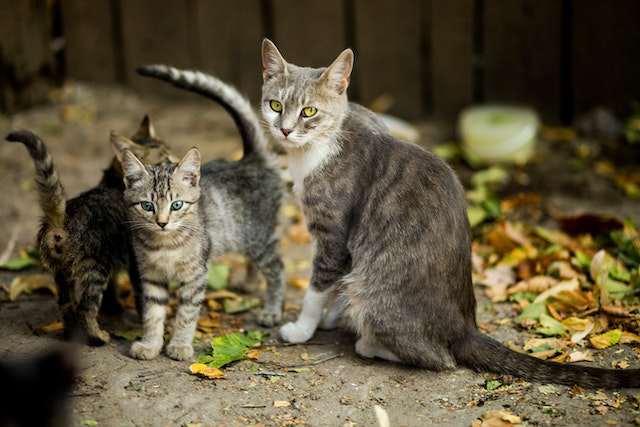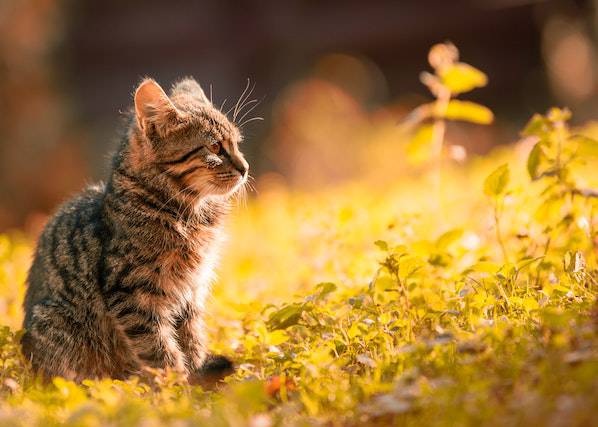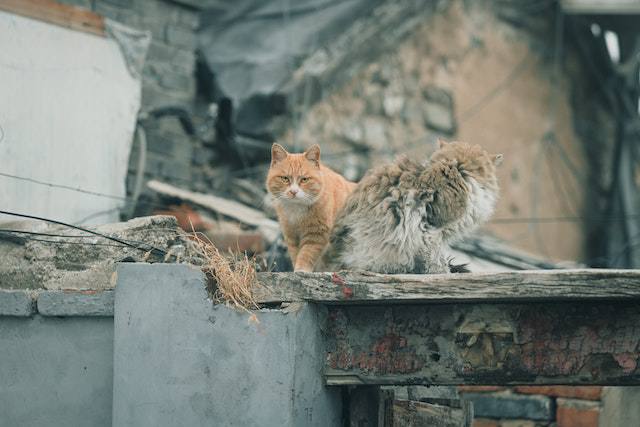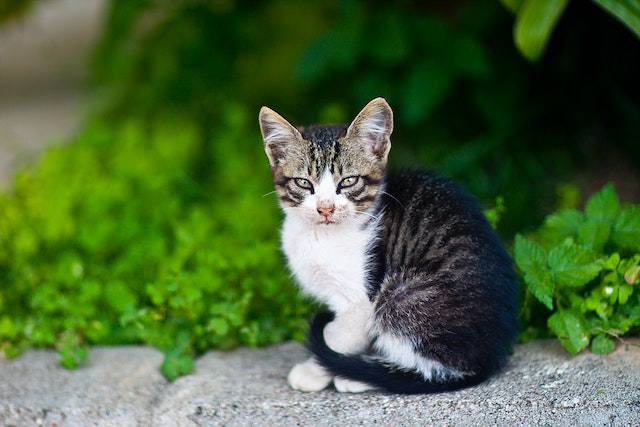11 Top Dangers of Outdoor Cats

Welcome to our latest blog post! Today, we want to discuss a very important topic that every cat owner should be aware of – the dangers of outdoor cats.
While it may seem harmless to let your furry friend roam freely in the great outdoors, there are actually many risks involved that could put your cat’s health and safety in jeopardy.
So, without further ado, let’s dive into the world of outdoor cat hazards and see how we can protect our feline friends!
Dangers of Outdoor Cats
The following are some of the most common dangers of outdoor cats:
1. Potential Traffic Accidents
Cats’ innate curiosity and agile nature may lead them to venture onto roads and streets without fully comprehending the potential dangers.
Unlike humans, cats lack an understanding of speeding vehicles and traffic patterns, making them vulnerable to accidents.
The fast-paced nature of roads can leave cats with little time to react, leading to life-threatening collisions with cars and other vehicles.
2. Disease Exposure

When outdoor cats come into contact with feral or unvaccinated cats, they are at greater risk of contracting infectious diseases.
Feline Leukemia Virus (FeLV) and Feline Immunodeficiency Virus (FIV) are especially concerning, as they weaken a cat’s immune system, making them susceptible to a range of illnesses and infections.
Additionally, rabies, a fatal viral disease, can also be transmitted to cats through contact with infected animals, posing a serious risk to both felines and humans.
3. Cat Fights and Injuries
While cats are known for their independent and sometimes aloof nature, they are also territorial animals.
When outdoor cats cross paths with other roaming felines, disputes over territory can escalate into aggressive fights.
These skirmishes often result in painful bite wounds, scratches, and deep abscesses that necessitate medical intervention.
Learn more about if outdoor cats are happier than indoor cats.
4. Risk of Poisoning
The great outdoors might seem like a fascinating playground for cats, but it also hides potential hazards.
Certain plants commonly found in gardens, such as lilies, azaleas, and sago palms, are highly toxic to cats and can cause severe poisoning if ingested.
Moreover, chemicals like pesticides, insecticides, and rodenticides used for pest control can be lethal to cats if accidentally ingested or absorbed through their paws or fur.
5. Risk of Predators
When outdoor cats venture beyond the safe confines of our homes, they enter territories where larger predators roam.
Urban and suburban areas might still harbor foxes, coyotes, and stray dogs, all of which view domestic cats as potential prey.
The instinctual curiosity that makes our feline friends so endearing can put them at risk of encountering these formidable predators, leading to tragic and avoidable encounters.
6. Risk of Parasites

The great outdoors is a breeding ground for parasites that can latch onto cats during their adventures.
Ticks, fleas, and worms are common culprits that can cause numerous health problems. Flea infestations can lead to severe itching and skin irritation, while ticks can transmit dangerous diseases like Lyme disease.
Intestinal parasites, such as roundworms and hookworms, can lead to malnutrition and other health issues if left untreated.
7. Legal Issues
Beyond the dangers our outdoor cats face, we must also consider local laws and regulations.
In some areas, letting cats roam freely outdoors may be prohibited due to concerns about wildlife conservation, public safety, or nuisance complaints.
Pet owners found in violation of these laws may face fines or legal consequences, emphasizing the importance of being aware of and respecting local regulations.
8. Getting Lost
The allure of the outdoors can be captivating for cats, leading them to wander far from their homes.
When cats get lost, they face numerous challenges, including finding food and shelter, avoiding danger, and navigating unfamiliar terrain.
As time passes, the chances of a successful reunion with their owners decrease, leaving them vulnerable to starvation, accidents, and exposure to the elements.
Learn more about why cats disappear without a trace.
9. Disruption of Wildlife
Cats are natural predators with strong hunting instincts. When allowed to roam freely outdoors, they can wreak havoc on local wildlife populations.
The predation of birds, rodents, and small mammals can lead to a decline in these species and disrupt the delicate ecological balance of the environment.
Learn more about outdoor cat life expectancy.
10. Human Cruelty
Sadly, not everyone treats animals with kindness and compassion. Outdoor cats are more exposed to interactions with people who may not have their best interests at heart.
They could be subject to mistreatment, abuse, or even intentional harm, leading to physical injuries and emotional trauma.
11. Risk of Harsh Weather Conditions
Cats are domesticated animals, and unlike their wild counterparts, they rely on us to provide shelter and protection from the elements.
Extreme cold, heavy rain and snowstorms can take a toll on outdoor cats, leading to hypothermia, frostbite, and other weather-related health issues.
Learn more about the benefits of keeping outdoor cats.
Tips to ensure indoor cats live happy and fulfilled lives

Here are some practical tips to ensure indoor cats live happy and fulfilled lives:
- Spaying/Neutering: If you decide to allow supervised outdoor time, ensure your cat is spayed or neutered to prevent unwanted litters and reduce the urge to roam.
- Provide a fresh litter box: Most house cats are indoor cats, which means you will need a litter box. A litter box is convenient but needs to be cleaned every day to avoid unpleasant odors.
- Window Views: Position perches or cat beds near windows to allow your feline companion to observe the outside world while remaining safe indoors.
- Consistent grooming: Although a cat might not need the same amount of grooming as a dog, it still takes work to prevent your house from turning into one big hairball. Weekly cleaning is usually enough.
- Interactive toys: Use a variety of toys to help your cat practice hunting and get the physical activity they need.
- Catios: Consider building a catio or enclosed outdoor space that allows your cat to experience the outdoors safely. Catios provide fresh air, sunshine, and a connection to nature without exposing cats to the risks of unrestricted outdoor access.
- Scratching post: It is important for cats to scratch, it helps them to keep their claws healthy and mark their territory. A scratching post is a great solution to prevent your furniture from being destroyed.
- Provide a perch or a comfortable spot: Cats love to be up high and observe their surroundings. Provide a comfortable spot for them to relax and keep an eye out for what’s happening.
- Water: Make sure your cat always has access to fresh water.
- Healthy food: Choose high-quality food that is designed for cats. Ask your vet for advice if needed.
- Playtime with your cat: Spend quality time with your cat, this helps to build a stronger bond and can reduce stress and anxiety.
- Regular vet check-ups: This ensures that your cat stays healthy and can catch any potential issues early on.
Learn more about transitioning outdoor cats to indoors.
Related Questions
How dangerous is it to let my cat roam outside?
Outdoor cats are susceptible to many dangers, including being hit by cars, getting into fights with other animals, and contracting diseases. Additionally, outdoor cats may prey on birds and other wildlife, posing a threat to local ecosystems. To keep your cat safe, it’s best to keep them indoors or let them outside only in a secure enclosure.
Learn more about cats hanging around your house.
What diseases can outdoor cats catch?
Outdoor cats may be exposed to various diseases, including feline leukemia virus, feline immunodeficiency virus, and toxoplasmosis. These diseases can have serious health consequences for cats and may also impact humans who come into contact with contaminated feces or urine. Keeping your cat indoors or providing a secure outdoor enclosure can help prevent exposure to these diseases.
Can outdoor cats harm local wildlife?
Yes, outdoor cats are natural hunters and may prey on birds, small mammals, and other wildlife. This can disrupt local ecosystems and impact the populations of various species. Keeping your cat indoors or providing a secure outdoor enclosure can help minimize their impact on wildlife.
Learn more about keeping your outdoor cat warm in winter.
How can I keep my cat safe if I want to let them outside?
If you want to let your cat outside, consider providing a secure outdoor enclosure, covering your yard with a cat-proof fence, or using a leash or harness to keep your cat under control. Be sure to supervise your cat while they are outside and take precautions to keep them safe from potential dangers.
Are outdoor cats more likely to get into fights with other animals?
Yes, outdoor cats may encounter other cats, dogs, and wildlife while they are outside, increasing their risk of getting into fights and suffering injuries. To reduce the risk of fights, consider keeping your cat indoors or providing a secure outdoor enclosure.
Can outdoor cats be at risk of being stolen?
Yes, outdoor cats can be at risk of theft, especially if they are rare breeds or have valuable characteristics. To minimize the risk of theft, consider microchipping your cat and keeping them indoors or under supervision while outside. It’s also a good idea to keep your cat’s medical records and photos on hand in case they go missing.
Conclusion
As cat owners, we all love to see our furry companions roam around and explore the great outdoors. However, as much as we enjoy their freedom, there are dangers to outdoor cats that we can’t ignore.
From predators to cars on the road, the risks to outdoor cats are many. Protect your beloved pet by keeping them indoors, and if outdoor time is a must, always supervise them and ensure they are wearing a collar with identification. After all, their safety should always come first.
